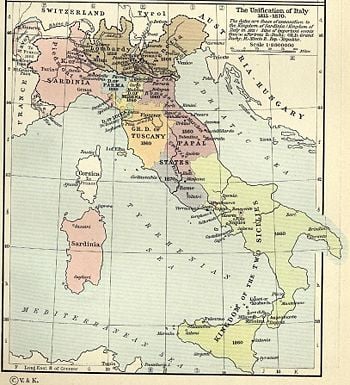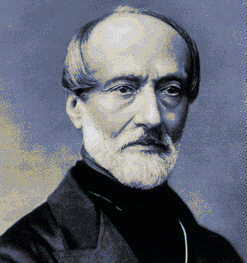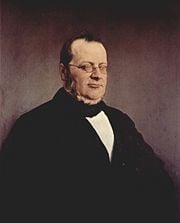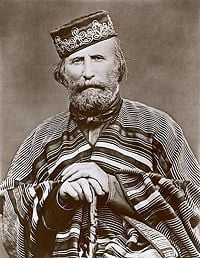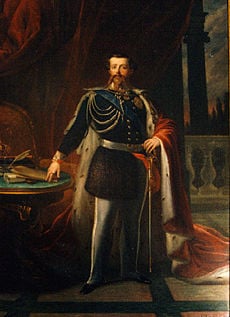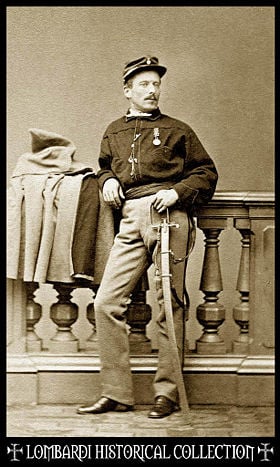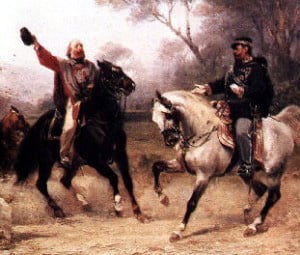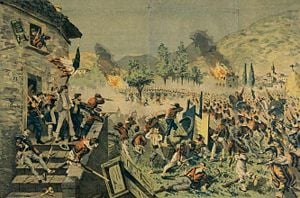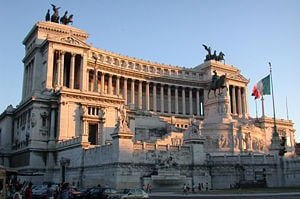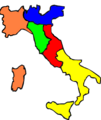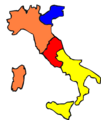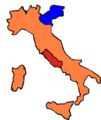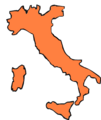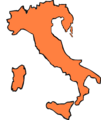Italian unification
Italian Unification (Italian: il Risorgimento, or "The Resurgence") was the political and social movement that unified different states of the Italian peninsula into the single nation of Italy. The Southern, republican drive for unification was led by Giuseppe Garibaldi, while the Northern, royalist drive was led by Camillo B, royalist enso, conte di Cavour. Piedomont king, Victor Emmanuel II became first King of the unified kingdom of Italy, which lasted until 1946 when, following World War II Italy became a republic. Unification saw the demise of the Papal States. Rome became the capita. There is a lack of consensus on the exact dates for the beginning and the end of Italian reunification, but many scholars agree that the process began with the end of Napoleonic rule and the Congress of Vienna in 1815, and more or less ended with the Franco-Prussian War in 1871, though the last città irredente, Trento and Triest, did not join Italy until after World War I. Napoleon also launched the process by which German states achieved unification at the same point in history.[1]
Ideas of the new kingdom as the modern-day successor of the Roman Empire soon led to the birth of colonial ambition. Reviving the notion of the Mediterranean Sea as mare nostrum (our sea, that is, a domestic pond), Italy looked across to Africa and gained its first foothold in Eritrea in 1885. Between 1936 and 1943, Fascist Italy was officially called the Italian Empire. That collapsed after World War II, when fascist dictator Benito Mussolini sided with Adolf Hitler's Third Reich. Mussolini saw himself as the great leader of a great Empire, a self-image that would have been unthinkable without unification. Post-world war, however, Italy has channeled its unification impetus into working for European unity. Alcide De Gasperi, architect of Italy's post-war reconstruction, is a "father" of the European Union. Just as unification ended war between Italian states, so European unity has ended war between members of the EU.
Background
The establishment of the Italian Republic and later of the Napoleonic Kingdom of Italy, ruled by Napoleon, began to encourage nationalism in those who lived in the regions. As Napoleon's reign began to fail, other national monarchs he had installed tried to keep their thrones by feeding those nationalistic sentiments, setting the stage for the revolutions to come. Among these monarchs were the viceroy of Italy, Eugène de Beauharnais, who tried to get Austrian approval for his succession to the Kingdom of Italy, and Joachim Murat, who called for Italian patriots' help for the unification of Italy under his rule.[2] Following the defeat of Napoleonic France, the Congress of Vienna (1815) was convened to redraw the European continent. In Italy, the Congress restored the pre-Napoleonic patchwork of independent governments, either directly ruled or strongly influenced by the prevailing European powers, particularly Austria.
But groups in several Italian states began to push the idea of a unified Italian state again, feeding the fires of nationalism that had already been ignited in the populace. At the time, the struggle for Italian unification was perceived to be waged primarily against the Austrian Empire and the Habsburgs, since they directly controlled the predominantly Italian-speaking northeastern part of present-day Italy and were the single most powerful force against unification. The Austrian Empire vigorously repressed nationalist sentiment growing on the Italian peninsula, as well as in the other parts of Habsburg domains. Austrian Chancellor Franz Metternich an influential diplomat at the Congress of Vienna, stated that the word Italy was nothing more than "a geographic expression."[3]
Artistic and literary sentiment also turned towards nationalism, and perhaps the most famous of proto-nationalist works was Alessandro Manzoni's I Promessi Sposi (The Betrothed). Some read this novel as a thinly veiled allegorical critique of Austrian rule. The novel was published in 1827 and extensively revised in the following years. The 1840 version of I Promessi Sposi used a standardized version of the Tuscan dialect, a conscious effort by the author to provide a language commonly used by most Italians.
Those in favor of unification also faced opposition from the Holy See, particularly after failed attempts to broker a confederation with the Papal States, which would have left the Papacy with some measure of autonomy over the region. The pope at the time, Pius IX, feared that giving up power in the region could mean the persecution of Italian Catholics.[4]
Even among those who wanted to see the peninsula unified into one country, different groups could not agree on what form a unified state would take. Vincenzo Gioberti, a Piedmontese priest, had suggested a confederation of Italian states under rulership of the Pope. His book, Of the Moral and Civil Primacy of the Italians, was published in 1843 and created a link between the Papacy and the Risorgimento. Many leading revolutionaries wanted a republic, but eventually it was a king and his chief minister who had the power to unite the Italian states as a monarchy.
One of the most influential revolutionary groups was the Carbonari (coal-burners), a secret organization formed in southern Italy early in the 19th century. Inspired by the principles of the French Revolution, its members were mainly drawn from the middle class and intellectuals. After the Congress of Vienna divided the Italian peninsula among the European powers, the Carbonari movement spread into the Papal States, the Kingdom of Sardinia, the Grand Duchy of Tuscany, the Duchy of Modena and the Kingdom of Lombardy-Venetia. The revolutionaries were so feared that the reigning authorities passed an ordinance condemning to death anyone who attended a Carbonari meeting. The society, however, continued to exist and was at the root of many of the political disturbances in Italy from 1820 until after unification. The Carbonari condemned Napoleon III to death for failing to unite Italy, and the group almost succeeded in assassinating him in 1858. Many leaders of the unification movement were at one time members of this organization.
Two prominent radical figures in the unification movement were Giuseppe Mazzini and Giuseppe Garibaldi. The more conservative constitutional monarchic figures included Count Cavour and Victor Emmanuel II, who would later become the first king of a united Italy.
Mazzini's activity in revolutionary movements caused him to be imprisoned soon after he joined. While in prison, he concluded that Italy could - and therefore should - be unified and formulated his program for establishing a free, independent, and republican nation with Rome as its capital. After Mazzini's release in 1831, he went to Marseille, where he organized a new political society called La Giovine Italia (Young Italy). The new society, whose motto was "God and the People," sought the unification of Italy.
Garibaldi, a native of Nice (then part of the Kingdom of Sardinia), participated in an uprising in Piedmont in 1834, was sentenced to death, and escaped to South America. He spent fourteen years there, taking part in several wars, and returned to Italy in 1848.
Early revolutionary activity (1820–1830)
Carbonari insurrections (1820–1821)
In 1814 the Carbonari began organizing revolutionary activities.
Two Sicilies insurrection
In 1820, Spaniards successfully revolted over disputes about the constitution, which influenced the development of a similar movement in Italy. Inspired by the Spaniards, (who, in 1812, had created their constitution) a regiment in the army of the Kingdom of Two Sicilies, commanded by Guglielmo Pepe, a Carbonari, mutinied, conquering the peninsular part of Two Sicilies. The king, Ferdinand I, agreed to enact a new constitution. The revolutionaries, though, failed to court popular support and fell to Austrian troops of the Holy Alliance. Ferdinand abolished the constitution and began systematically persecuting known revolutionaries. Many supporters of revolution in Sicily, including the scholar Michele Amari, were forced into exile during the decades that followed.
Piedmont insurrection
The leader of the 1821 revolutionary movement in Piedmont was Santorre di Santarosa, who wanted to remove the Austrians and unify Italy under the House of Savoy. The Piedmont revolt started in Alessandria, where troops adopted the green, white and red tricolore of the Cisalpine Republic. The king's regent, prince Charles Albert, acting while the king Charles Felix was away, approved a new constitution to appease the revolutionaries, but when the king returned he disavowed the constitution and requested assistance from the Holy Alliance. Di Santarosa's troops were defeated, and the would-be Piedmontese revolutionary fled to Paris.
1830 insurrections
By 1830, revolutionary sentiment in favor of a unified Italy began to experience a resurgence, and a series of insurrections laid the groundwork for the creation of one nation along the Italian peninsula.
The Duke of Modena, Francis IV, was an ambitious noble, and he hoped to become king of Northern Italy by increasing his territory. In 1826, Francis made it clear that he would not act against those who subverted opposition toward the unification of Italy. Encouraged by the declaration, revolutionaries in the region began to organize.
During the July Revolution of 1830 in France, revolutionaries forced the king to abdicate and created the July Monarchy with encouragement from the new French king, Louis-Philippe. Louis-Philippe had promised revolutionaries such as Ciro Menotti that he would intervene if Austria tried to interfere in Italy with troops. Fearing he would lose his throne, though, Louis-Philippe did not intervene in Menotti's planned uprising. The Duke of Modena abandoned his Carbonari supporters, arrested Menotti and other conspirators in 1831, and once again conquered his duchy with help from the Austrian troops. Menotti was executed, and the idea of a revolution centered in Modena faded.
At the same time, other insurrections arose in the Papal Legations of Bologna, Forlì, Ravenna, Imola, Ferrara, Pesaro and Urbino. These successful revolutions, which adopted the tricolore in favor of the Papal flag, quickly spread to cover all the Papal Legations, and their newly installed local governments proclaimed the creation of a united Italian nation.
The revolts in Modena and the Papal Legations inspired similar activity in the Duchy of Parma, where the tricolore flag was adopted. The Parmese duchess Marie Louise left the city during the political upheaval.
Insurrected provinces planned to unite as the Province Italiane unite (united Italian Provinces), which prompted Pope Gregory XVI to ask for Austrian help against the rebels. Metternich warned Louis-Philippe that Austria had no intention to let Italian matters be, and that French intervention would not be tolerated. Louis-Philippe withheld any military help and even arrested Italian patriots living in France.
In the spring of 1831, the Austrian army began its march across the Italian peninsula, slowly crushing resistance in each province that had revolted. This military action suppressed much of the fledging revolutionary movement, and resulted in the arrest of many radical leaders, including Menotti.
Revolutions of 1848–1849
In January 1848, the revolutionary disturbances began on January 5 with a civil disobedience strike in Lombardy, as citizens stopped smoking and playing the lottery, which denied Austria the associated tax revenue. Shortly after this, revolts began on the island of Sicily against King Ferdinand, who conceded as he had in 1821 and granted Sicily a constitution, as well as releasing political prisoners. Disquiet spread to Naples, where the Neapolitan liberals demanded that they should also be granted a constitution. Ferdinand granted Naples a constitution on 29 January, a document that was identical to its Sicilian counterpart.
In February 1848 there were revolts in Tuscany that were relatively nonviolent, after which Ferdinand granted the Tuscans a constitution. A breakaway republican provisional government formed in Tuscany during February shortly after this concession. On February 21, Pope Pius IX granted a constitution to the Papal States, which was both unexpected and surprising considering the historical recalcitrance of the Papacy. On February 23, King Louis Philippe of France was forced to flee Paris, and a republic was proclaimed. By the time the revolution in Paris occurred, three states of Italy had constitutions—four if one considers Sicily to be a separate state.
Meanwhile in Lombardy tensions increased until the Milanese and Venetians rose up in revolt on 18 March 1848. The insurrection in Milan succeeded in expelling the Austrian garrison after five days of street fights ("Cinque giornate di Milano"). An Austrian army under Radetzky besieged Milan, but due to defection and the popularity of the Milanese, they were forced to retreat. Soon, Charles Albert, the King of Sardinia (whose kingdom was actually centered around Piedmont and Savoy), urged by the Venetians and Milanese to aid their cause, decided that this was the moment to unify Italy and declared war on Austria. After initial successes at Goito and Peschiera, he was decisively defeated at the Battle of Custoza on July 24, by the Austrian Marshal Josef Radetzky. An armistice was quickly agreed to, and Radetzky was able to regain control of all of Lombardy-Venetia save Venice itself, where a republic was proclaimed under Daniele Manin.
While Radetzky consolidated control of Lombardy-Venetia and Charles Albert licked his wounds, matters began to take a more serious turn in other parts of Italy. The monarchs who had so reluctantly agreed to constitutions in March began to come into conflict with their constitutional ministers, often leading to outright conflict. At first, the republics had the upper hand, forcing the monarchs to flee their capitals, including Pope Pius IX.
Pius IX had been initially seen as something of a reformer, but conflicts with the revolutionaries led him to sour on the idea of constitutional government. In November 1848, following the assassination of his Minister Pellegrino Rossi, Pius IX fled Rome. Subsequently, Garibaldi and other patriots arrived in Rome. In early 1849, elections were held for a Constituent Assembly, which proclaimed a Roman Republic on February 9. On February 2 1849, at a political rally held in the Apollo Theater, a young Roman priest, the Abbé Arduini, had made a speech in which he had declared that the temporal power of the popes was a "historical lie, a political imposture, and a religious immorality."[5]. In early March 1849, Mazzini arrived in Rome and was appointed Chief Minister. In the Constitution of the Roman Republic religious freedom was guaranteed by article 7, the independence of the pope as head of the Catholic Church was guaranteed by article 8 of the Principi fondamentali, while the death penalty was abolished by article 5, and free public education was provided by article 8 of the Titolo I.
Before the powers had a chance to respond to the founding of the Roman Republic, Charles Albert, whose army had been trained in the meanwhile by the exiled Polish general Albert Chrzanowski, determined to renew the war with Austria. He was quickly defeated by Radetzky at Novara on March 23, 1849. This time the defeat was final. Charles Albert himself abdicated in favor of his son, Victor Emmanuel II, and all Piedmontese ambitions to unite Italy or conquer Lombardy were, for the moment at least, brought to an end. The war was formally ended by a treaty signed on August 9. A popular revolt broke out in Brescia in the very day of the Novara defeat, but was fiercely suppressed by the Austrians ten days later.
There remained the Roman and Venetian Republics. In April a French force under Nicolas Oudinot was sent to Rome. Apparently, the French wished to mediate between the Pope and his subjects, but soon the French were forced to take sides, and determined to restore the Pope. After a two month siege, Rome capitulated on June 29, 1849, and the Pope was restored. Garibaldi and Mazzini once again fled into exile — in 1850 Garibaldi became a resident of New York City. Meanwhile, the Austrians besieged Venice, which was forced to surrender on August 24. The Austrians also moved to restore order in central Italy, restoring the princes who had been expelled and establishing their control over the Papal Legations. The revolutions were thus completely crushed.
Creation of the Italian State
The War of 1859 and its aftermath
Although Charles Albert had been crushingly defeated in his bid to drive the Austrians from Italy, the Piedmontese did not abandon all hope of aggrandizement. Camillo di Cavour, who became president of the Council of Ministers in 1852, also had expansionist ambitions. Cavour, however, saw that Piedmont would not be able to singlehandedly add to its territory. Instead, he hoped to secure aid from Britain and France in expelling the Austrians from the Italian peninsula. An attempt to gain British and French favor by supporting them in the Crimean War, which Piedmont entered in 1855, was unsuccessful, as Italian matters were ignored at the Congress of Paris. Nevertheless, the war achieved a useful objective—it left Austria, which had uncomfortably tried to balance between the two sides during the war, dangerously isolated.
On January 14, 1858, an Italian nationalist Felice Orsini attempted to assassinate Napoleon III, the French Emperor. Writing from his prison cell, Orsini did not plea for his life, accepting death for his role in the failed assassination attempt, but rather appealed to Napoleon III to fulfill his destiny by aiding the forces of Italian nationalism. Napoleon, who had belonged to the Carbonari in his youth, and who saw himself as an advanced thinker, in tune with the ideas of the day, became convinced that it was his destiny to do something for Italy. In the summer of 1858, Cavour met with Napoleon III at Plombières and the two signed a secret agreement, which was known as the Patto di Plombières ("Pact of Plombières").[6] Cavour and Napoleon III agreed to a joint war against Austria. Piedmont would gain the Austrian territories in Italy (Lombardy and Venetia), as well as the Duchies of Parma and Modena, while France would be rewarded with Piedmont's transalpine territories of Savoy and Nice. Central and Southern Italy would remain largely as it was, although there was some talk that the Emperor's cousin Prince Napoleon would replace the Habsburgs in Tuscany. In order to allow the French to intervene without appearing as the aggressors, Cavour was to provoke the Austrians into aggression by encouraging revolutionary activity in Lombardy.
At first, things did not work out as planned. The Austrians, ignorant of the secret agreement signed at Plombières, were surprisingly patient in dealing with the Piedmontese-inspired insurrections. The Piedmontese mobilization in March 1859 was then something of an admission of defeat, as it appeared that the strategy of provoking the Austrians into aggression had failed. Without Austrian aggression, the French could not intervene, and without French support, Cavour was unwilling to risk war. At this time however, the Austrians conveniently made their opponents' task easier by sending an ultimatum to the Piedmontese demanding demobilization. This the Piedmontese could conveniently reject and, by making Austria seem the aggressor, allowed the French to intervene.
The war itself was quite short. The Austrian advance into Piedmont was incompetent, and they were unable to secure the Alpine passes before the arrival of the French army, led personally by Napoleon. At the Battle of Magenta on June 4, the French and Sardinians were victorious over the Austrian army of Count Gyulai, leading to Austrian withdrawal from most of Lombardy and a triumphal entry by Napoleon and Victor Emmanuel into Milan. On June 24, a second battle was fought between the two armies at Solferino. This bloody engagement, at which the Austrian Emperor Franz Joseph had also taken personal command of his troops, saw little skill demonstrated by the leaders on either side, but the French were again victorious. The Austrians withdrew behind the Quadrilateral of fortresses on the borders of Venetia.
There were many reasons Napoleon III sought peace at this point. Fear that a long and bloody campaign would be necessary to conquer Venetia, fear for his position at home, worry at the intervention of German states, and fear of a too-powerful Piedmont-Sardinia led him to look for a way out. On July 11, he met privately with Franz Joseph at Villafranca, without the knowledge of his Piedmontese allies. Together, the two agreed on the outlines of a settlement to the conflict. The Austrians would retain Venetia, but would cede Lombardy to the French, who would then immediately cede it to Piedmont (the Austrians were unwilling to themselves cede the area to Piedmont). Otherwise, the Italian borders would remain unchanged. In Central Italy, where the authorities had universally been expelled following the outbreak of war, the rulers of Tuscany, Modena, and Parma, who had fled to Austria, would be restored, while Papal control of the Legations would be resumed. Because Napoleon had not fulfilled the terms of his agreement with Piedmont, he would not gain Savoy and Nice.
The Sardinians were outraged at this betrayal by their ally. Cavour demanded that the war be carried on regardless, and resigned when the more realistic Victor Emmanuel determined that acquiescence was the only realistic option. But the Villafranca agreement would prove a dead letter long before it was formalized into the Treaty of Zurich in November. Piedmontese troops occupied the smaller Italian states and the Legations, and the French proved unwilling to pressure them to withdraw and allow the restoration of the old order, while the Austrians no longer had the power to compel it. In December, Tuscany, Parma, Modena, and the Legations were unified into the United Provinces of Central Italy, and, encouraged by the British, were seeking annexation by the Kingdom of Sardinia.
Cavour, who triumphantly returned to power in January 1860, wished to annex the territories, but realized that French acquiescence was necessary. Napoleon III agreed to recognize the Piedmontese annexation in exchange for Savoy and Nice. On March 20, 1860, the annexations occurred. Now the Kingdom of Sardinia encompassed most of Northern and Central Italy.
The Mille expedition
Thus, by the spring of 1860, only four states remained in Italy - the Austrians in Venetia, the Papal States (now minus the Legations), the new expanded Kingdom of Piedmont-Sardinia, and the Kingdom of the Two Sicilies. There is no special reason to think that Cavour now envisaged the unification of the rest of Italy under Piedmontese rule, but events proved to have a life of their own.
Francis II of the Two Sicilies, the son and successor of Ferdinand II (the infamous "King Bomba"), had a well-organized army of 150,000 men. But his father's tyranny had inspired many secret societies, and the kingdom's Swiss Mercenaries were unexpectedly recalled home according to a new Swiss law, leaving Francis only his mostly unreliable native troops. It was a critical opportunity for the unification movement. In April 1860, separate insurrections began in Messina and Palermo in Sicily, both of which demonstrated a history of opposing Neapolitan rule. These rebellions were easily suppressed by loyal troops.
In the meantime, Garibaldi, a native of Nice, was deeply resentful of the French annexation of his home city. He hoped to use his supporters to regain the territory. Cavour, terrified of Garibaldi provoking a war with France, convinced Garibaldi to instead concentrate his forces on the Sicilian rebellions. On May 6, 1860, Garibaldi and his cadre of about a thousand Italian volunteers (called I Mille), steamed from Quarto near Genoa, and after a stop in Talamone on May 11 landed near Marsala on the west coast of Sicily.
Near Salemi, Garibaldi's army attracted scattered bands of rebels, and the combined forces defeated the opposing army at Calatafimi on May 13. Within three days, the invading force had swelled to 4000 men. On May 14, Garibaldi proclaimed himself dictator of Sicily, in the name of Victor Emmanuel. After waging various successful but hard-fought battles, Garibaldi advanced upon the Sicilian capital of Palermo, announcing his arrival by beacon-fires kindled at night. On May 27, the force laid siege to the Porta Termini of Palermo, while a mass uprising of street and barricade fighting broke out within the city.
With Palermo deemed insurgent, Neapolitan general Ferdinando Lanza, arriving in Sicily with some 25,000 troops, furiously bombarded Palermo nearly to ruins. With the intervention of a British admiral, an armistice was declared, leading to the Neapolitan troops' departure and surrender of the town to Garibaldi and his much smaller army.
This resounding success demonstrated the weakness of the Neapolitan government. Garibaldi's fame spread and many Italians began to consider him a national hero. Doubt, confusion and dismay overtook the Neapolitan court — the king hastily summoned his ministry and offered to restore an earlier constitution, but these efforts failed to rebuild the peoples' trust in Bourbon governance.
Six weeks after the surrender of Palermo, Garibaldi attacked Messina. Within a week its citadel surrendered. Having conquered Sicily, Garibaldi proceeded to the mainland, crossing the Straits of Messina with the Neapolitan fleet at hand. The garrison at Reggio Calabria promptly surrendered. Progressing northward, the populace everywhere hailed him and military resistance faded. At the end of August Garibaldi was at Cosenza, and on September 5 at Eboli, near Salerno. Meanwhile, Naples had been declared in a state of siege, and on September 6 the king gathered the 4,000 troops still faithful to him and retreated over the Volturno river. The next day Garibaldi, with a few followers, entered Naples, whose people openly welcomed him.
Defeat of Naples
Though Garibaldi had easily taken the capital, the Neapolitan army had not joined the rebellion en masse, holding firm along the Volturno River. Garibaldi's irregular bands of about 25,000 men could not drive away the king or take the fortresses of Capua and Gaeta without the help of the Sardinian army.
The Sardinian army, however, could only arrive by traversing the Papal States, which extended across the entire center of the peninsula. Ignoring the political will of the Holy See, Garibaldi announced his intent to proclaim a "Kingdom of Italy" from Rome, the capital city of Pope Pius IX. Seeing this as a threat to the domain of the Catholic Church, Pius threatened excommunication for those who supported such an effort. Afraid that Garibaldi would attack Rome, Catholics worldwide sent money and volunteers for the Papal Army, which was commanded by General Louis Lamoricière, a French exile.
The settling of the peninsular standoff now rested with Louis Napoleon. If the French emperor had let Garibaldi have his way the latter would likely have ended the temporal sovereignty of the pope and made Rome the capital of Italy. Napoleon, however, may have arranged with Cavour to leave the king of Sardinia free to take possession of Naples, Umbria and the other provinces, provided that Rome and the "patrimony of St. Peter" were left intact.
It was in this situation that a Sardinian force of two army corps, under Fanti and Cialdini, marched to the frontier of the Papal States, its objective being not Rome but Naples. The Papal troops under Lamoricière advanced against Cialdini, but were quickly defeated and besieged in the fortress of Ancona, finally surrendering on September 29. On October 9, Victor Emmanuel II arrived and took command. There was no longer a papal army to oppose him, and the march southward proceeded unopposed.
Garibaldi distrusted the pragmatic Cavour, particularly due to Cavour's role in the French annexation of Nice, Garibaldi's birthplace. Nevertheless, he accepted the command of Victor Emmanuel. When the king entered Sessa Aurunca at the head of his army, Garibaldi willingly handed over his dictatorial power. After greeting Victor Emmanuel in Teano with the title of King of Italy, Garibaldi entered Naples riding beside the king. Garibaldi then retired to the island of Caprera, while the remaining work of unifying the peninsula was left to Victor Emmanuel.
The progress of the Sardinian army compelled Francis II to give up his line along the river, and he eventually took refuge with his best troops in the fortress of Gaeta. His courage boosted by his resolute young wife, Duchess Marie Sophie of Bavaria, Francis mounted a stubborn defense that lasted three months. But European allies refused him aid, food and munitions became scarce, and disease set in, so the garrison was forced to surrender. Nonetheless, ragtag groups of Neapolitans loyal to Francis would fight on against the Italian government for years to come.
The fall of Gaeta brought the unification movement to the brink of fruition — only Rome and Venetia remained to be added. On February 18, 1861, Victor Emmanuel assembled the deputies of the first Italian Parliament in Turin. On March 17 1861, the Parliament proclaimed Victor Emmanuel II King of Italy, and on March 27 1861 Rome was declared Capital of Italy. Three months later Cavour, having seen his life's work nearly complete, died. When he was given the last rites, Cavour purportedly said: "Italy is made. All is safe."[7]
Roman Question
Mazzini was discontented with the perpetuation of monarchical government, and continued to agitate for a republic. With the motto "Free from the Alps to the Adriatic," the unification movement set its gaze on Rome and Venice. There were obstacles, though. A challenge against the Pope's temporal domain was viewed with great distrust by Catholics around the world, and French troops were stationed in Rome. Victor Emmanuel was wary of the international repercussions of attacking the Papal States, and discouraged his subjects from participating in revolutionary ventures with such intentions.
Nonetheless, Garibaldi believed that the government would support him if he attacked Rome. Frustrated at inaction by the king, and bristling over perceived snubs, he organized a new venture. In June 1862, he sailed from Genoa and landed again at Palermo, where he gathered volunteers for the campaign, under the slogan Roma o Morte (Rome or Death). The garrison of Messina, loyal to the king's instructions, barred their passage to the mainland. Garibaldi's force, now numbering two thousand, turned south and set sail from Catania. Garibaldi declared that he would enter Rome as a victor or perish beneath its walls. He landed at Melito on August 14, and marched at once into the Calabrian mountains.
Far from supporting this endeavor, the Italian government was quite disapproving. General Cialdini dispatched a division of the regular army, under Colonel Pallavicino, against the volunteer bands. On August 28 the two forces met in the Aspromonte. One of the regulars fired a chance shot, and several volleys followed, but Garibaldi forbade his men to return fire on fellow subjects of the Kingdom of Italy. The volunteers suffered several casualties, and Garibaldi himself was wounded; many were taken prisoner. Garibaldi was taken by steamer to Varignano, where he was honorably imprisoned for a time, but finally released.
Meanwhile, Victor Emmanuel sought a safer means to the acquisition of the Papal States. He negotiated the removal of the French troops from Rome through a treaty, the September Convention, with Napoleon III in September 1864, by which the emperor agreed to withdraw his troops within two years. The pope was to expand his own army during that time so as to be self-sufficient. In December 1866, the last of the French troops departed from Rome, in spite of the efforts of the pope to retain them. By their withdrawal Italy was freed from the presence of foreign soldiers for the first time probably in a thousand years.
The seat of government was moved in 1865 from Turin, the old Sardinian capital, to Florence, where the first Italian parliament was summoned. This arrangement created such disturbances in Turin that the king was forced to leave that city hastily for his new capital.
Third Independence War (1866)
In the Austro-Prussian War of 1866, Austria contested with Prussia the position of leadership among the German states. The Kingdom of Italy seized the opportunity to capture Venetia from Austrian rule and allied itself with Prussia. Austria tried to convince the Italian government to accept Venetia in exchange for non-intervention. However, on April 8, Italy and Prussia signed an agreement that supported Italy's acquisition of Venetia, and on June 20, Italy declared war on Austria. Within the context of Italian unification, the Austro-Prussian war is called Third Independence War, after the First (1848) and the Second (1859).
Victor Emmanuel hastened to lead an army across the Mincio to the invasion of Venetia, while Garibaldi was to invade the Tyrol with his Hunters of the Alps. The enterprise ended in disaster. The Italian army encountered the Austrians at Custoza on June 24 and suffered a defeat. On July 20 the Regia Marina was defeated in the battle of Lissa. Italy's fortunes were not all so dismal, though. The following day, Garibaldi's volunteers defeated an Austrian force in the battle of Bezzecca, and moved toward Trento.
Meanwhile, Prussian Prime Minister Otto von Bismarck saw that his own ends in the war had been achieved, and signed an armistice with Austria on July 26. Italy officially laid down its arms on August 12. Garibaldi was called back from his successful march and resigned with a brief telegram reading only "Obbedisco" ("I obey").
In spite of Italy's poor showing, Prussia's success on the northern front obliged Austria to cede Venetia. Under the terms of a peace treaty signed in Vienna on October 12, Emperor Franz Joseph had already agreed to cede Venetia to Napoleon III in exchange for non-intervention in the Austro-Prussian War and thus Napoleon III ceded Venetia to Italy on October 19 in exchange for the earlier Italian acquiescence to the French annexation of Savoy.
In the peace treaty of Vienna, it was written that the annexation of Venetia would have become effective only after a referendum—taken on October 21 and October 22—to let the Venetian people express their will about being annexed or not to the Kingdom of Italy. Some historians suggest that the referendum in Venetia was held under military pressure,[8] as a mere 0.01 percent of voters (69 out of more than 642,000 ballots) voted against the annexation.[9] Many Venetian independence movements refer to this deceit to claim for independence of Veneto.
Austrian forces put up some opposition to the invading Italians, to little effect. Victor Emmanuel entered Venice in triumph, and performed an act of homage in the Piazza San Marco.
Rome
Mentana and Villa Glori
The national party, with Garibaldi at its head, still aimed at the possession of Rome, as the historic capital of the peninsula. In 1867 Garibaldi made a second attempt to capture Rome, but the papal army, strengthened with a new French auxiliary force, defeated his badly armed volunteers at Mentana. Subsequently, a French garrison remained in Civitavecchia until August 1870, when it was recalled following the outbreak of the Franco-Prussian War.
Before the defeat at Mentana, Enrico Cairoli, his brother Giovanni and 70 companions had made a daring attempt to take Rome. The group had embarked in Terni and floated down the Tiber. Their arrival in Rome was to coincide with an uprising inside the city. On October 22, 1867, the revolutionaries inside Rome seized control of the Capitoline Hill and of Piazza Colonna. Unfortunately, when the Cairoli and their companions arrived at Villa Glori, on the northern outskirts of Rome, the uprising had already been suppressed. During the night of October 22, 1867, the group was surrounded by papal Zouaves, and Giovanni was severely wounded. Enrico was mortally wounded and bled to death in Giovanni's arms.
At the summit of Villa Glori, near the spot where Enrico died, there is a plain white column dedicated to the Cairoli brothers and their 70 companions. About 100 meters to the left from the top of the Spanish Steps, there is a bronze monument of Giovanni holding the dying Enrico in his arm. A plaque lists the names of their companions. Giovanni never recovered from his wounds and from the tragic events of 1867. According to an eyewitness[10], when Giovanni died on 11 September 1869:
- Negli ultimi momenti gli parve vedere Garibaldi e fece vista di accoglierlo con trasporto. Udii (così narra un amico presente) che disse tre volte: "L'unione dei francesi ai papalini fu il fatto terribile!" pensava a Mentana. Chiamò più volte Enrico, suo fratello, "perché lo aiutasse!" poi disse: "ma vinceremo di certo; andremo a Roma!"
- In the last moments, he had a vision of Garibaldi and seemed to greet him with enthusiasm. I heard (so says a friend who was present) him say three times: "The union of the French to the papal political supporters was the terrible fact!" he was thinking about Mentana. Many times he called Enrico, that he might help him! then he said: "but we will certainly win; we will go to Rome!"
Capture of Rome
In July 1870, the Franco-Prussian War began. In early August, the French Emperor Napoleon III recalled his garrison from Rome, thus no longer providing protection to the Papal State. Widespread public demonstrations illustrate the demand that the Italian government take Rome. The Italian government took no direct action until the collapse of the Second French Empire at the Battle of Sedan. King Victor Emmanuel II sent Count Ponza di San Martino to Pius IX with a personal letter offering a face-saving proposal that would have allowed the peaceful entry of the Italian Army into Rome, under the guise of offering protection to the pope. The Papacy, however, exhibited something less than enthusiasm for the plan:
- The Pope’s reception of San Martino (10 September 1870) was unfriendly. Pius IX allowed violent outbursts to escape him. Throwing the King’s letter upon the table he exclaimed, "Fine loyalty! You are all a set of vipers, of whited sepulchres, and wanting in faith." He was perhaps alluding to other letters received from the King. After, growing calmer, he exclaimed: "I am no prophet, nor son of a prophet, but I tell you, you will never enter Rome!" San Martino was so mortified that he left the next day.[11]
The Italian Army, commanded by General Raffaele Cadorna, crossed the papal frontier on 11 September and advanced slowly toward Rome, hoping that a peaceful entry could be negotiated. The Italian Army reached the Aurelian Walls on 19 September and placed Rome under a state of siege. Although now convinced of his unavoidable defeat, Pius IX remained intransigent to the bitter end and forced his troops to put up a token resistance. On September 20, after a cannonade of three hours had breached the Aurelian Walls at Porta Pia, the Bersaglieri entered Rome and marched down Via Pia, which was subsequently renamed Via XX Settembre. 49 Italian soldiers and four officers, and 19 papal troops died. Rome and Latium were annexed to the Kingdom of Italy after a plebiscite held on October 9.
Initially the Italian government had offered to let the pope keep Leonine City, but the Pope rejected the offer because acceptance would have been an implied endorsement of the legitimacy of the Italian kingdom's rule over his former domain. Pius IX declared himself a prisoner in the Vatican, although he was not actually restrained from coming and going. Rather, being deposed and stripped of much of his former power also removed a measure of personal protection—if he had walked the streets of Rome he might have been in danger from political opponents who had formerly kept their views private. Officially, the capital was not moved from Florence to Rome until July 1871.
Historian Raffaele de Cesare made the following observations about Italian unification:
- The Roman question was the stone tied to Napoleon’s feet—that dragged him into the abyss. He never forgot, even in August 1870, a month before Sedan, that he was a sovereign of a Catholic country, that he had been made Emperor, and was supported by the votes of the Conservatives and the influence of the clergy; and that it was his supreme duty not to abandon the Pontiff. [12]
- For twenty years Napoleon III had been the true sovereign of Rome, where he had many friends and relations…. Without him the temporal power would never have been reconstituted, nor, being reconstituted, would have endured. [13]
Risorgimento in the Modern era
The process of unification of the Italian people in a national State was not completed in the nineteenth century. Many Italians remained outside the borders of the Kingdom of Italy and this situation created the Italian irredentism.
Italia irredenta (Unredeemed Italy) was an Italian nationalist opinion movement that emerged after Italian unification. It advocated irredentism[14] among the Italian people as well as other nationalities who were willing to become Italian and as a movement; it is also known as "Italian irredentism." Not a formal organization, it was just an opinion movement that claimed that Italy had to reach its "natural borders." Similar patriotic and nationalistic ideas were common in Europe in the 19th century.
Irredentism and the two World Wars
Italian irredentism succeeded in World War I with the annexation of Trieste and Trento, with the respective territories of Venezia Giulia and Trentino. During the post-unification era, some Italians were unsatisfied with the current state of the Italian Kingdom since they wanted the kingdom to include Trieste, Istria and other areas around as well. This discontent was finally resolved with the annexation of the region.
The Kingdom of Italy had declared neutrality at the beginning of the war, officially because the Triple Alliance with Germany and Austria-Hungary was a defensive one, requiring its members to come under attack first. Many Italians were still hostile to Austrian historical and continuing occupations of ethnically Italian areas, and Italy chose not to enter. Austria-Hungary requested Italian neutrality, while the Triple Entente (which included Great Britain, France and Russia) its intervention. With the London Pact, signed in April 1915, Italy accepted to declare war against the Central Powers, in exchange for the irredent territories of Friuli, Trentino and Dalmatia.
Italian irredentism obtained an important result after World War I, when Italy gained Trieste, Gorizia, Istria and the city of Zara. During WWII, after the Axis aggression against Yugoslavia, Italy created the "Governatorato di Dalmazia" (from 1941 to September 1943), so the Kingdom of Italy annexed temporarily even Spalato (Split), Cattaro (Kotor) and most of coastal Dalmatia. From 1942 to 1943 even Corsica (Corse) and Nizza (Nice) were temporarily annexed to the Kingdom of Italy, nearly totally fulfilling in those years the requests of the Italian irredentism.
The movement had for its avowed purpose the emancipation of all Italian lands still subject to foreign rule after Italian unification. The Irredentists took language as the test of the alleged Italian nationality of the countries they proposed to emancipate, which were Trentino, Trieste, Dalmatia, Istria, Gorizia, Ticino, Nice (Nizza), Corsica and Malta. Austria-Hungary promoted Croatian interests in Dalmatia and Istria to weaken Italian claims in the western Balkans before WWI.
After World War II
After WWII the irredentism movement faded away in Italian politics. Only a few thousand Italians remain in Istria and Dalmatia as a consequence of the Italian defeat in WWII and of the slaughter of approximately 2,000 Italians (mostly soldiers) and the subsequent choice of Italian citizenship by an additional 200,000 - 250,000 people in what became known as the Istrian exodus.
Secession movements
The Italian unification process was generally popular with contemporary people living in the Italian peninsula, especially with regard to the end to Austrian rule. Nevertheless, dissenters were present in the 19th century (in particular, the rulers of the annexed states), and regionalist sympathies continue to the present day. There are two chief secession movements, (that in the past reached less than 5% of the national electoral votes and currently in the last 2008 national election reached about 10% nationwide and 20% in the north) represented by active political parties: one in the North (Lega Nord), and one in the South (Due Sicilie). This southern secession movement was mainly the result of peasants revolting against the new government. The former has elected several representatives to the national parliament.
The Italian region of Alto Adige/South Tyrol had a strong secession movement, headed by the Austro-Germanic majority in the region, for unification with Austria. The movement was strongest after the Second World War. Secessionist parties still exist, but the secessionist movement has been mostly pacified by the granting of substantial autonomy by the Italian government.
Legacy of Unification: Italy in the European Union=
The rise of Italian fascism may have had it roots in the establishment of a larger Italian entity. Idea of imperial grandeur, of joining, even belatedly, the European scramble for colonies, the concept of the strong leader of a proud and great people, all stand behind Mussolini's version of fascism.
Following World War II, the dynamics of unification of Italy merged with the process of European unification, and Italy was one of the founding members of the European Economic Community. Ideas similar to those that promoted the Risorgimento among the Italian people are in part responsible for the wide acceptance in Italy of the political ideas related to the formation of the Union. Imperial ambition to dominate other people, also a product of unification but never enthusiastically espoused by the majority of Italians, more or less died with the collapse of Italian fascism. Economics can be said to have replaced imperialism. Italy, with the seventh largest economy in the world, is a member of the G8.
Maps of Italian unification
Notes
- ↑ Napoleon abolished the smaller German states in 1803 and wanted to unify the larger ones. After his defeat, the German Confederation was formed in 1815 with 39 states. In 1866 this was dissolved and the North German Confederation founded. In 1871, Germany became a unified state under Prussia.
- ↑ Gioacchino Napeoleon, 1815. Italiani (Proclamation of Rimini). Regione Piemonte. Gioacchino Napoleon Murat, Napoleon's brother-in-law, was made King of Naples in 1808 and reigned until 1818.
- ↑ Tommaso Astarita. 2005. Between salt water and holy water: a history of Southern Italy. (New York, NY: W.W. Norton & Company. ISBN 9780393058642), 264.
- ↑ E.E.Y. Hales. 1954. Pio Nono: A Study in European Politics and Religion in the Nineteenth Century. (New York, NY: P.J. Kenedy.)
- ↑ Jasper Ridley. 2001. Garibaldi. (London, UK: Phoenix. ISBN 9781842121528), 268
- ↑ Brian J. Hayes, 2008. Italian Unification. Cavour, Garibaldi and the Making of Italy. Age of the Sage. Retrieved August 23, 2008.
- ↑ Edgar Holt. 1971. The Making of Italy 1815–1870. (New York, NY: Atheneum), 258.
- ↑ G. Thaon di Revel, 2002. La cessione del Veneto - ricordi di un commissario piemontese incaricato alle trattative (translation: "The cession of Veneto - memories of the piedmontese commissary for the negotiations"). (Academic Press.)
- ↑ Ettore Beggiato, 1999. 1866: la grande truffa. (translation: "1866: the great deceit"). (Venezia, IT: Editoria universitaria.)
- ↑ Rosi, Michele. 1929. I Cairoli, Bologna, IT: L. Capelli Ed. pages 223–224.
- ↑ Raffaele De Cesare, Helen Zimmern, and George Macaulay Trevelyan. 1909. The last days of papal Rome, 1850-1870. (London, UK: A. Constable and Co.), 444. Online at The Internet Archive. Retrieved August 23, 2008.
- ↑ De Cesare, 1909, 440.
- ↑ De Cesare, 1909, 443.
- ↑ Belief that people of the same ethnicity should belong to the same political entity.
ReferencesISBN links support NWE through referral fees
- Astarita, Tommaso. 2005. Between salt water and holy water: a history of Southern Italy. New York, NY: W.W. Norton & Company. ISBN 9780393058642.
- Beggiato, Ettore. 1999. 1866: la grande truffa. (translation: "1866: the great deceit"). Venezia, IT: Editoria universitaria.
- Collier, Martin. 2003. Italian unification, 1820-71. (Heinemann advanced history.) Oxford, UK: Heinemann. ISBN 9780435327545.
- Davis, John A. 2000. Italy in the Nineteenth Century. London, UK: Oxford University Press. ISBN 9780198731283.
- De Cesare, Raffaele, Helen Zimmern, and George Macaulay Trevelyan. 1909. The last days of papal Rome, 1850-1870. London, UK: A. Constable and Co. Online at The Internet Archive. Retrieved August 23, 2008.
- di Revel, G. Thaon. 2002. La cessione del Veneto - ricordi di un commissario piemontese incaricato alle trattative (translation: "The cession of Veneto - memories of the piedmontese commissary for the negotiations"). Academic Press.
- Hales, E.E.Y.. 1954. Pio Nono: A Study in European Politics and Religion in the Nineteenth Century. New York, NY: P.J. Kenedy.
- Hales, E.E.Y. 1958. The Catholic Church in the Modern World. New York, NY: Doubleday.
- Hibbert, Christopher. 2008. Garibaldi: hero of Italian unification. Basingstoke, UK: Palgrave Macmillan. ISBN 9780230606067.
- Holt, Edgar. 1971. The Making of Italy 1815–1870. New York, NY: Atheneum.
- Lloyd, Richard Leslie Harris. 1975. Cavour and Italian unification, 1854-1860. (The archive series.) London, UK: Edward Arnold. ISBN 9780713118629.
- Mouritsen, Henrik. 1998. Italian unification: a study in ancient and modern historiography. London, UK: Institute of Classical Studies, School of Advanced Study, University of London. ISBN 9780900587818.
- Ridley, Jasper. 2001. Garibaldi. London, UK: Phoenix. ISBN 9781842121528.
- Rosi, Michele. 1929. I Cairoli. Bologna, IT: L. Capelli Ed.
External links
All links retrieved December 13, 2024.
- Women of the Risorgimento.
- Garibaldi & The Risorgimento.
- Italian Unification. Cavour, Garibaldi and the Making of Italy essay.
Credits
New World Encyclopedia writers and editors rewrote and completed the Wikipedia article in accordance with New World Encyclopedia standards. This article abides by terms of the Creative Commons CC-by-sa 3.0 License (CC-by-sa), which may be used and disseminated with proper attribution. Credit is due under the terms of this license that can reference both the New World Encyclopedia contributors and the selfless volunteer contributors of the Wikimedia Foundation. To cite this article click here for a list of acceptable citing formats.The history of earlier contributions by wikipedians is accessible to researchers here:
The history of this article since it was imported to New World Encyclopedia:
Note: Some restrictions may apply to use of individual images which are separately licensed.
